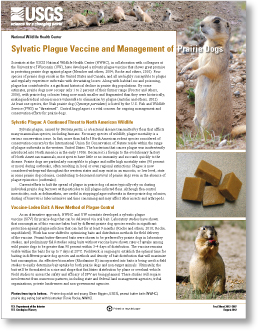Fact Sheet 2012–3087

SummaryScientists at the USGS National Wildlife Health Center (NWHC), in collaboration with colleagues at the University of Wisconsin (UW), have developed a sylvatic plague vaccine that shows great promise in protecting prairie dogs against plague (Mencher and others, 2004; Rocke and others, 2010). Four species of prairie dogs reside in the United States and Canada, and all are highly susceptible to plague and regularly experience outbreaks with devastating losses. Along with habitat loss and poisoning, plague has contributed to a significant historical decline in prairie dog populations. By some estimates, prairie dogs now occupy only 1 to 2 percent of their former range (Proctor and others, 2006), with prairie dog colonies being now much smaller and fragmented than they were historically, making individual colonies more vulnerable to elimination by plague (Antolin and others, 2002). At least one species, the Utah prairie dog (Cynomys parvidens) is listed by the U.S. Fish and Wildlife Service (FWS) as “threatened”. Controlling plague is a vital concern for ongoing management and conservation efforts for prairie dogs. Current efforts to halt the spread of plague in prairie dog colonies typically rely on dusting individual prairie dog burrows with pesticides to kill plague-infected fleas. Although flea-control insecticides, such as deltamethrin, are useful in stopping plague outbreaks in these prairie dog colonies, dusting of burrows is labor intensive and time consuming and may affect other insects and arthropods. As an alternative approach, NWHC and UW scientists developed a sylvatic plague vaccine (SPV) for prairie dogs that can be delivered via oral bait. Laboratory studies have shown that consumption of this vaccine-laden bait by different prairie dog species results in significant protection against plague infection that can last for at least 9 months (Rocke and others, 2010; Rocke, unpublished). Work has now shifted to optimizing baits and distribution methods for field delivery of the vaccine. Ultimately, the bait will be formulated in a size and shape that facilitates distribution by plane or overland vehicle. Field studies to assess the safety and efficacy of SPV are being planned. These studies will require involvement from numerous partners, including state and federal land management agencies, tribal organizations, private landowners and non-government agencies. |
First posted September 19, 2012 For additional information contact: Part or all of this report is presented in Portable Document Format (PDF); the latest version of Adobe Reader or similar software is required to view it. Download the latest version of Adobe Reader, free of charge. |
Rocke, Tonie E., 2012, Sylvatic plague vaccine and management of prairie dogs: U.S. Geological Survey Fact Sheet 2012–3087, 2 p.